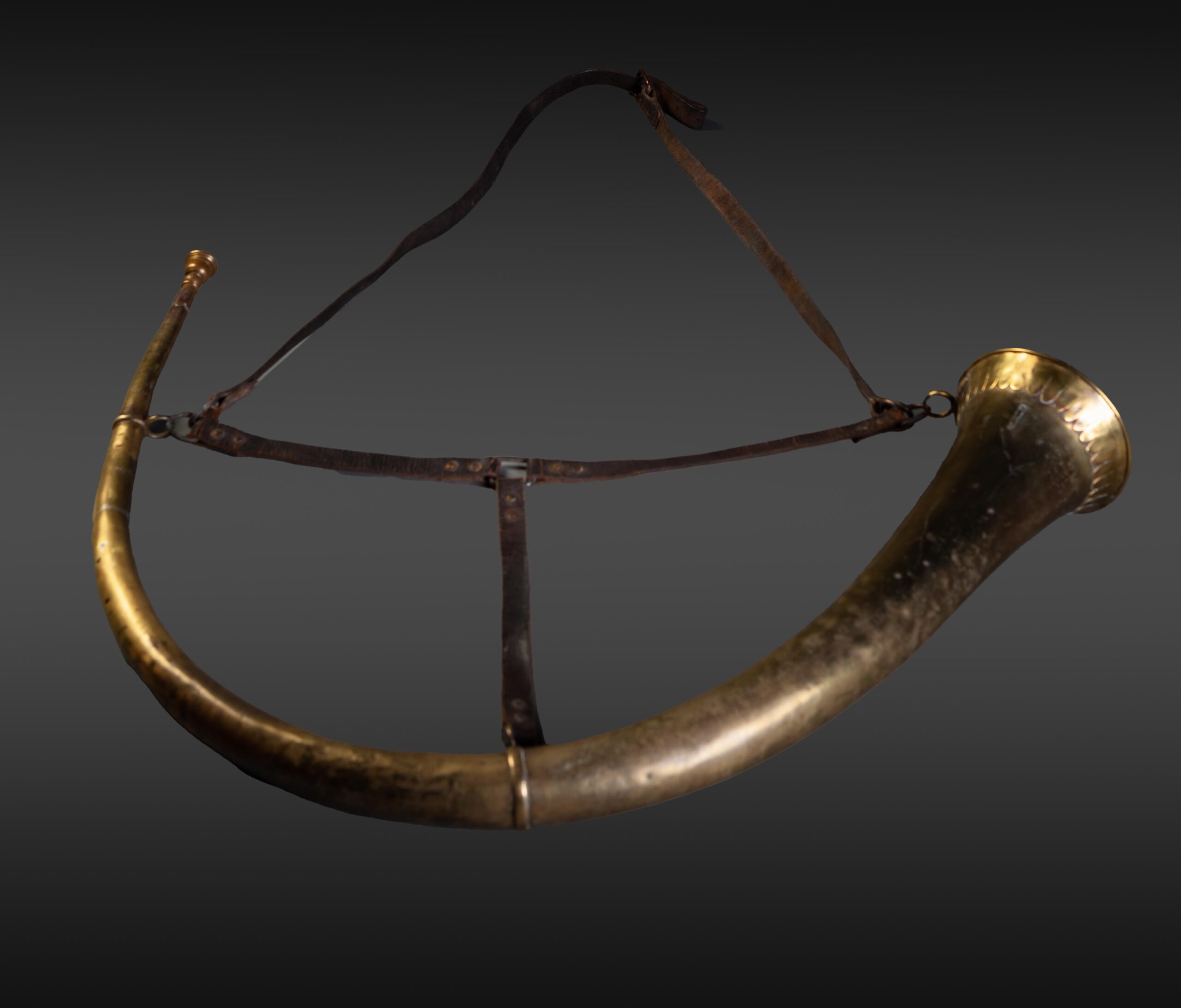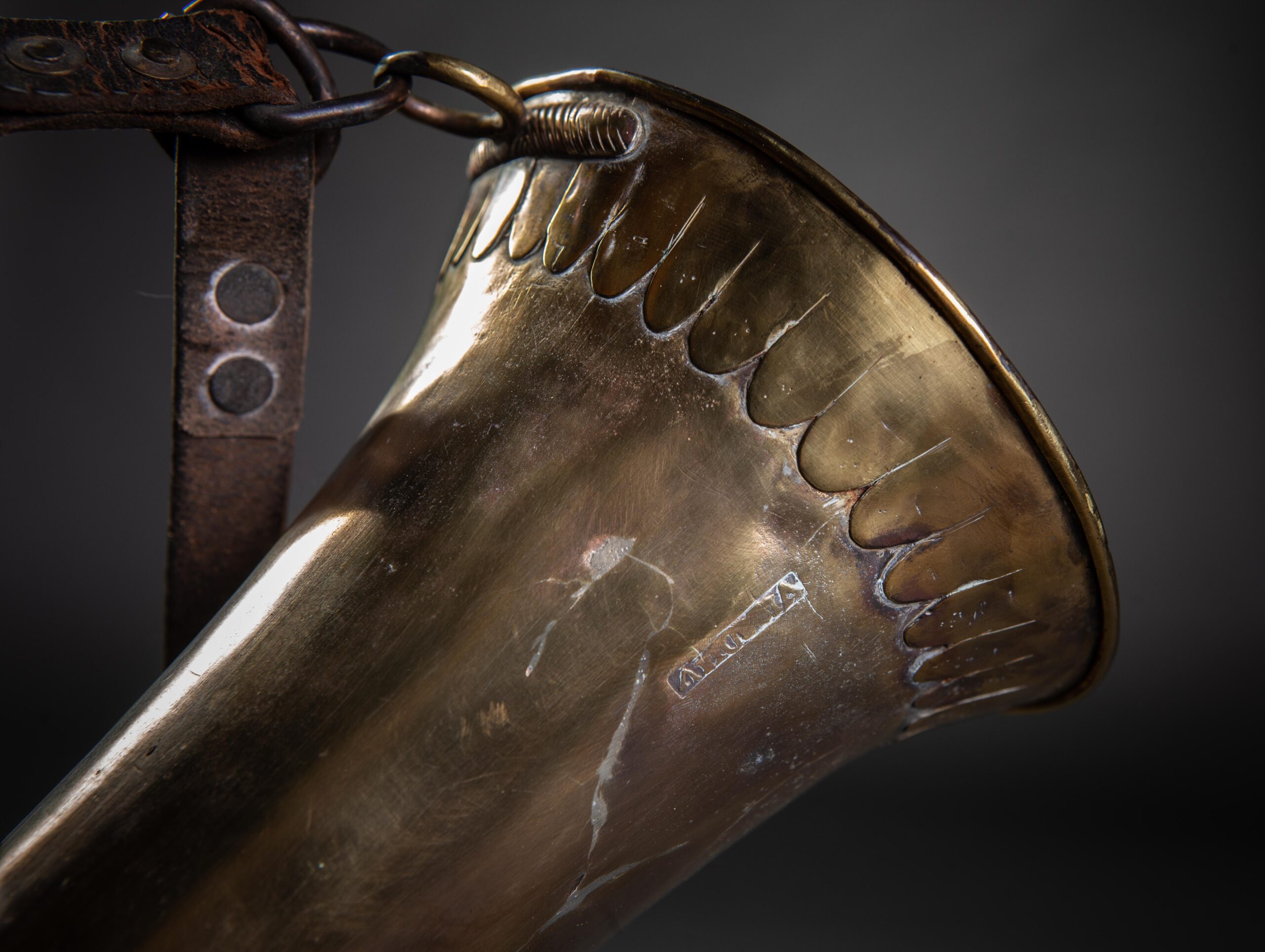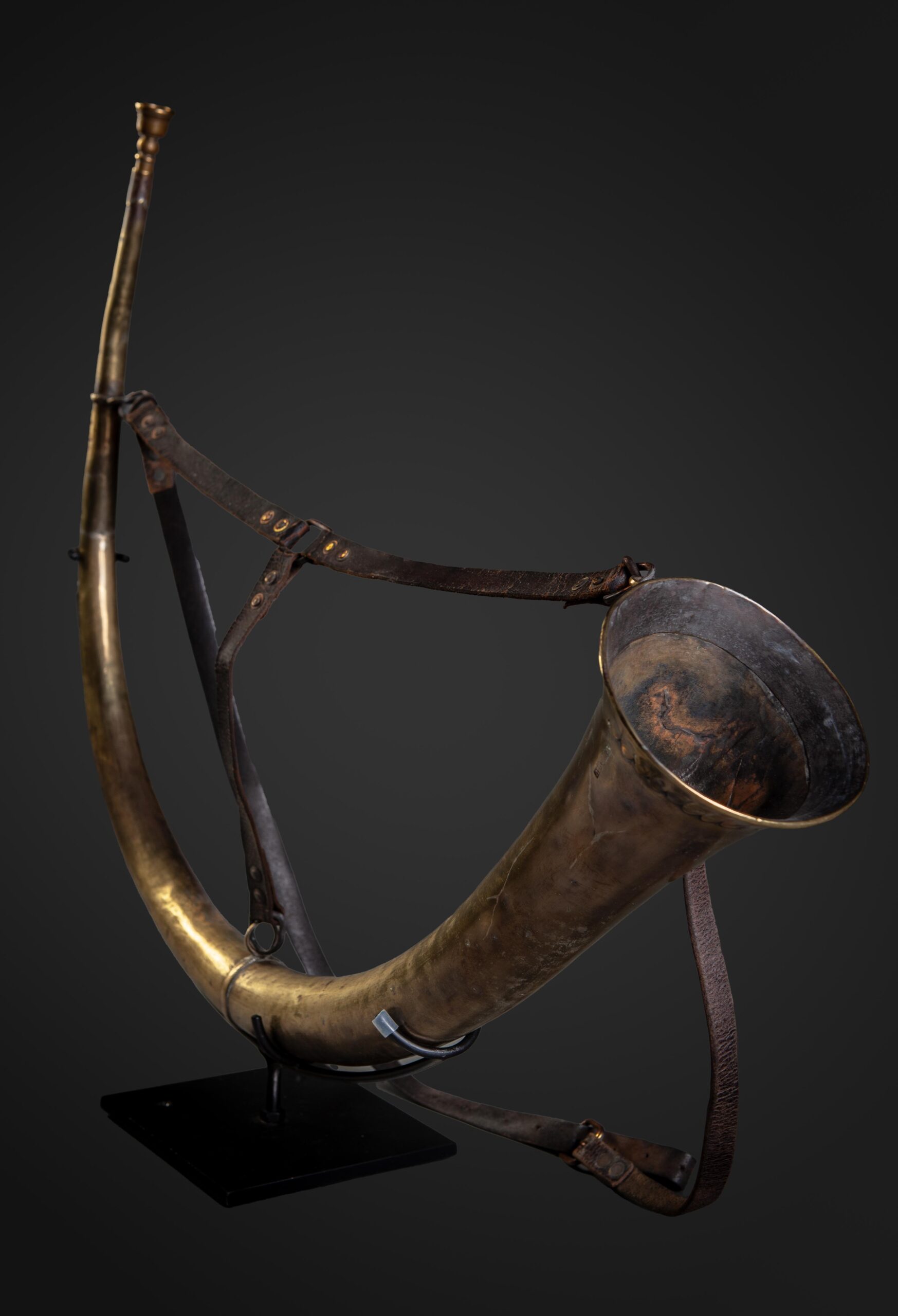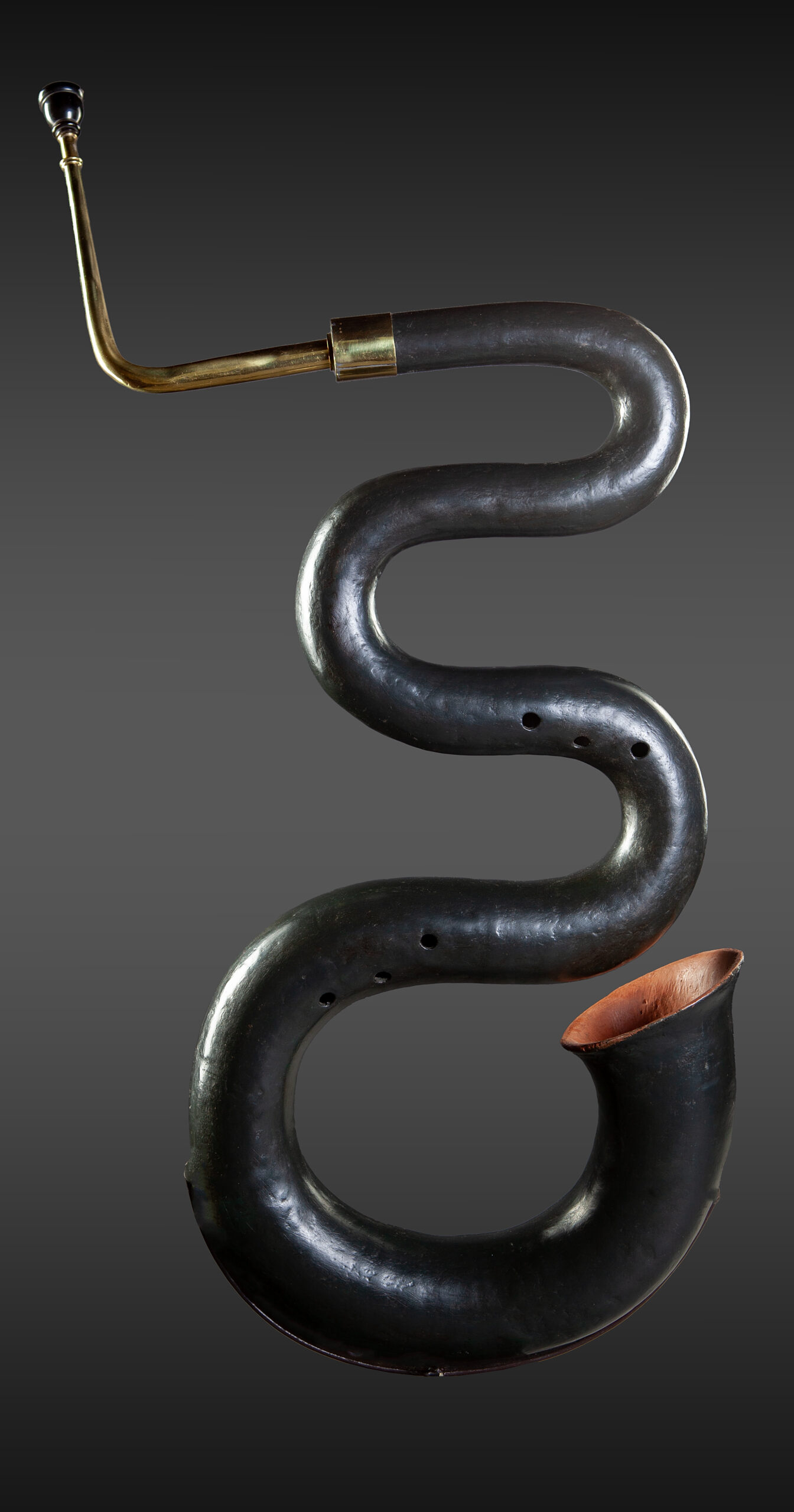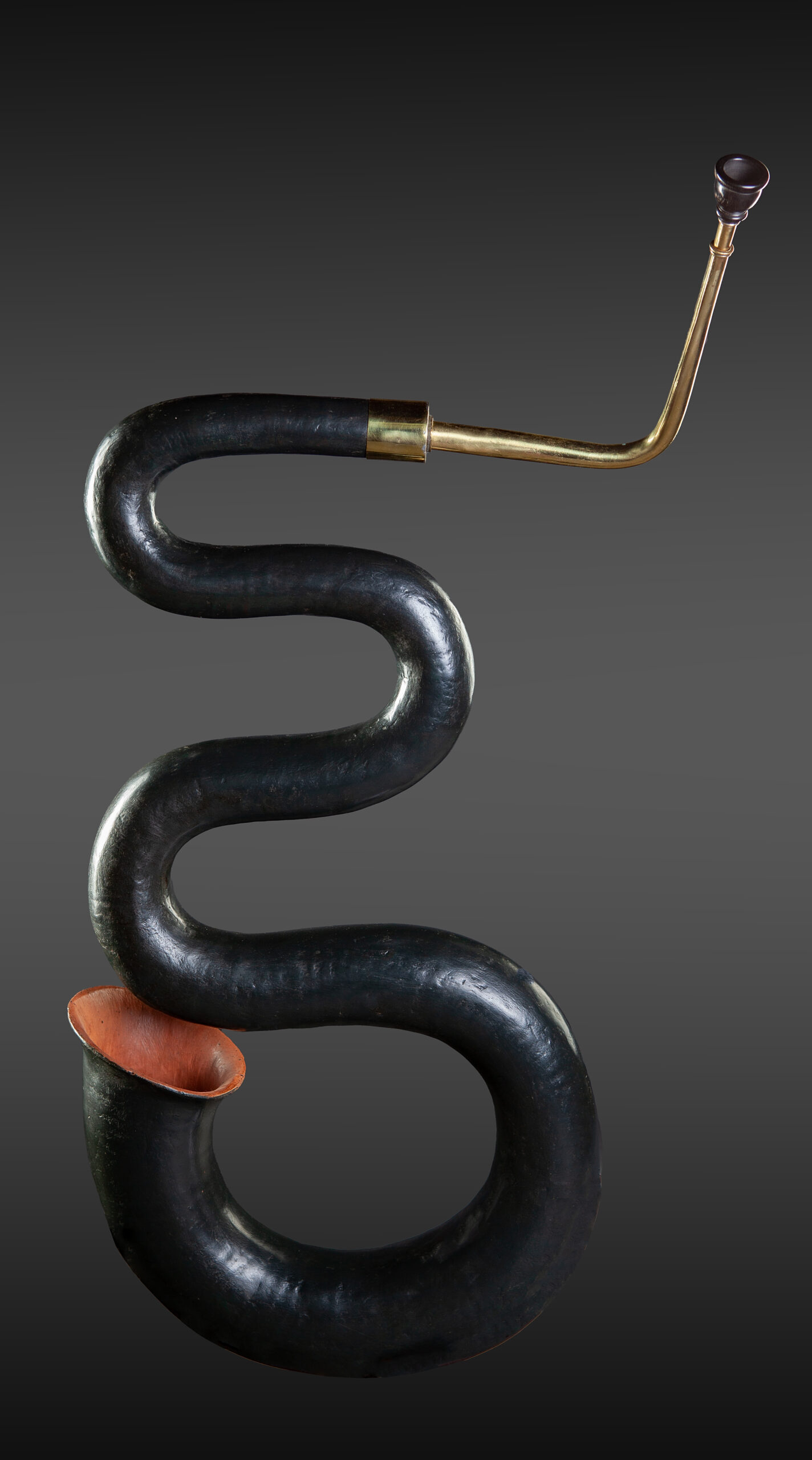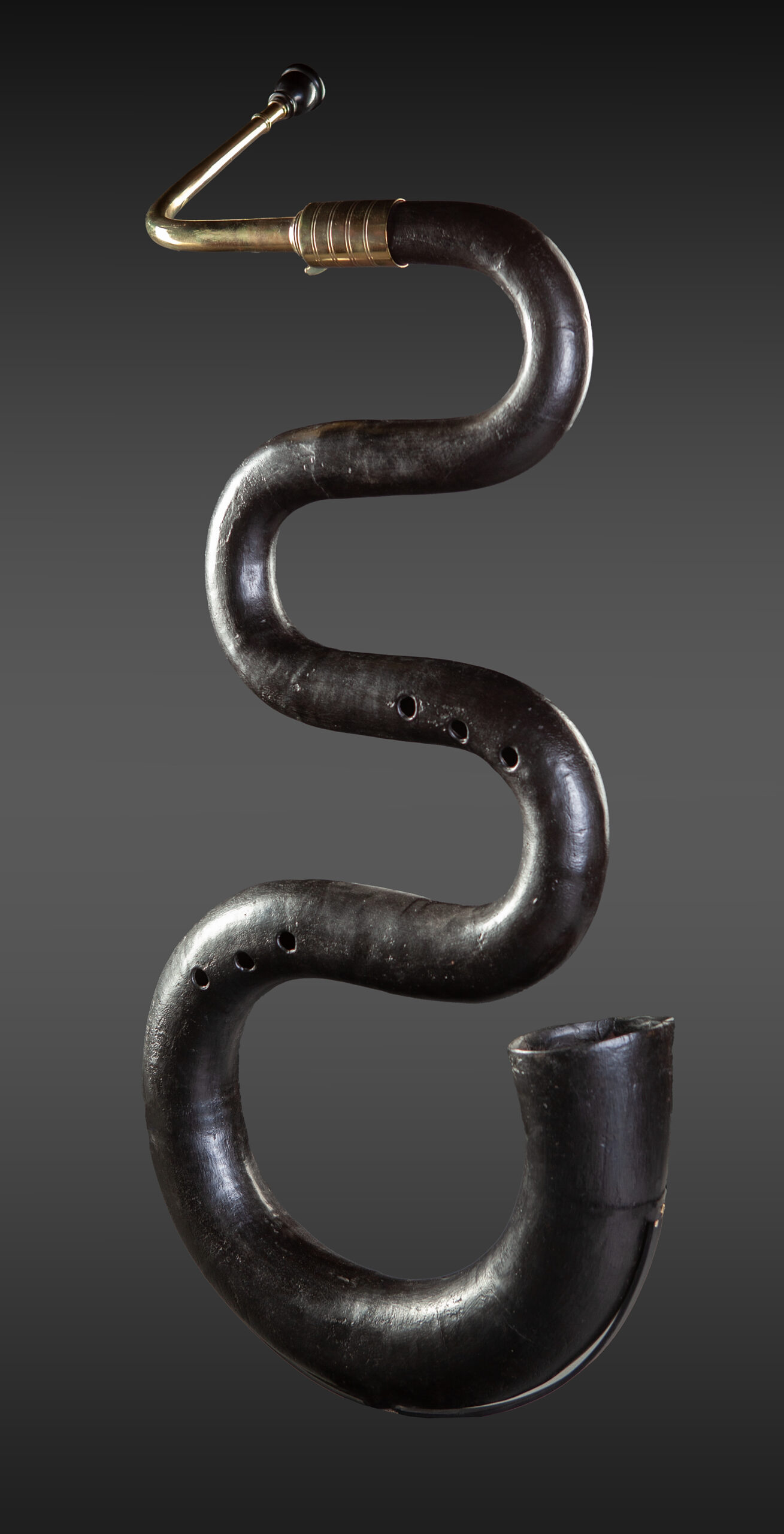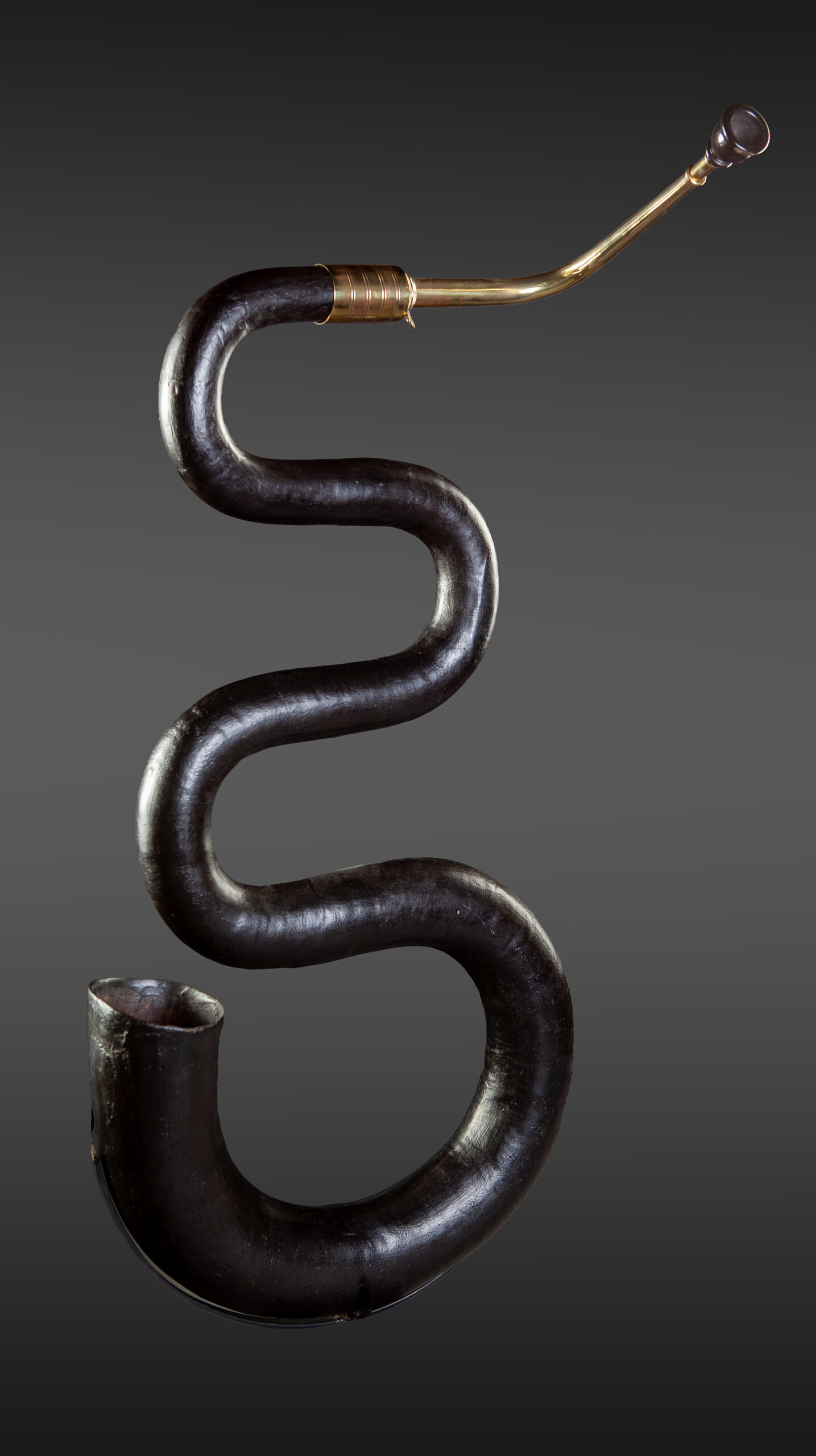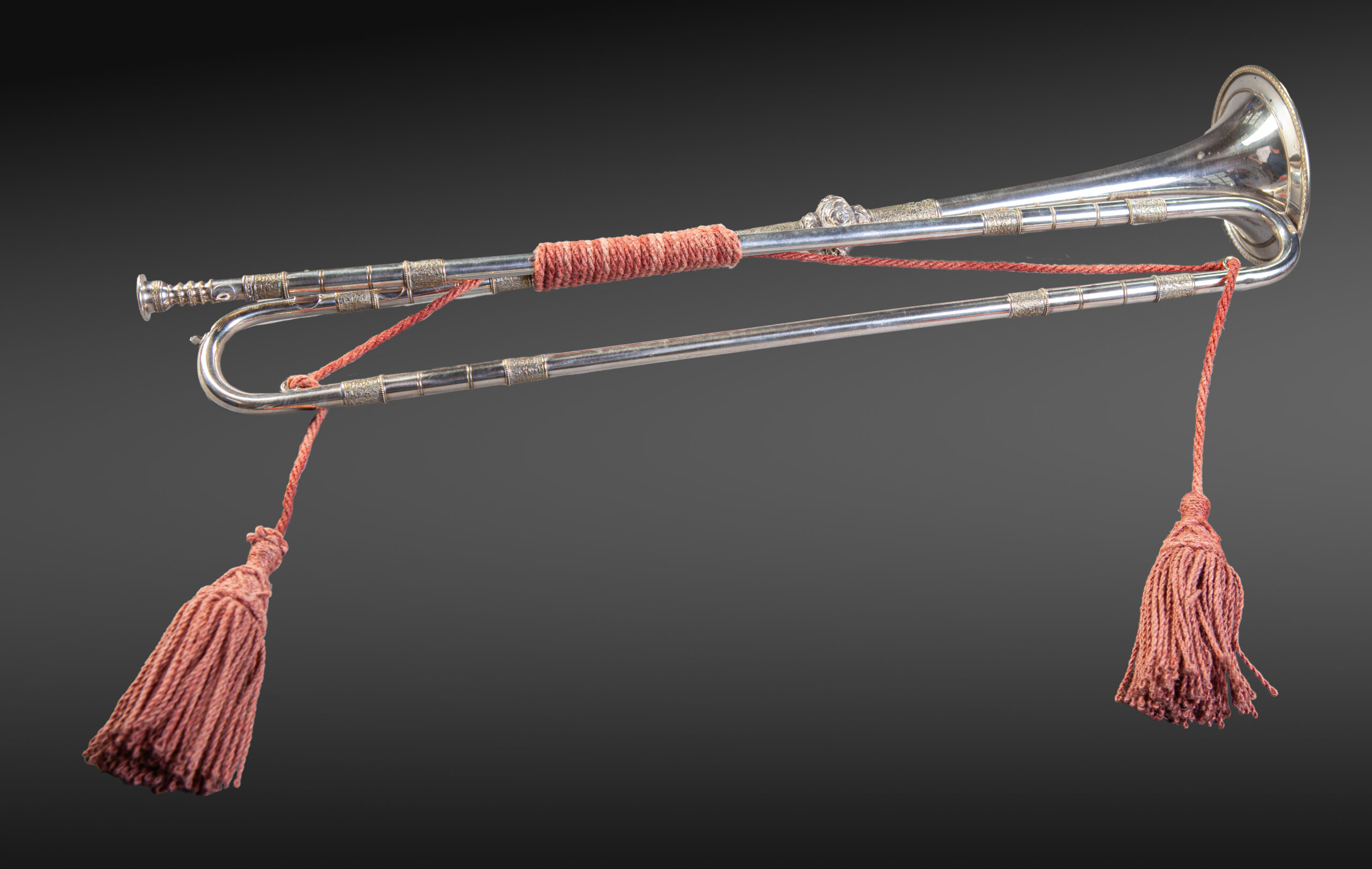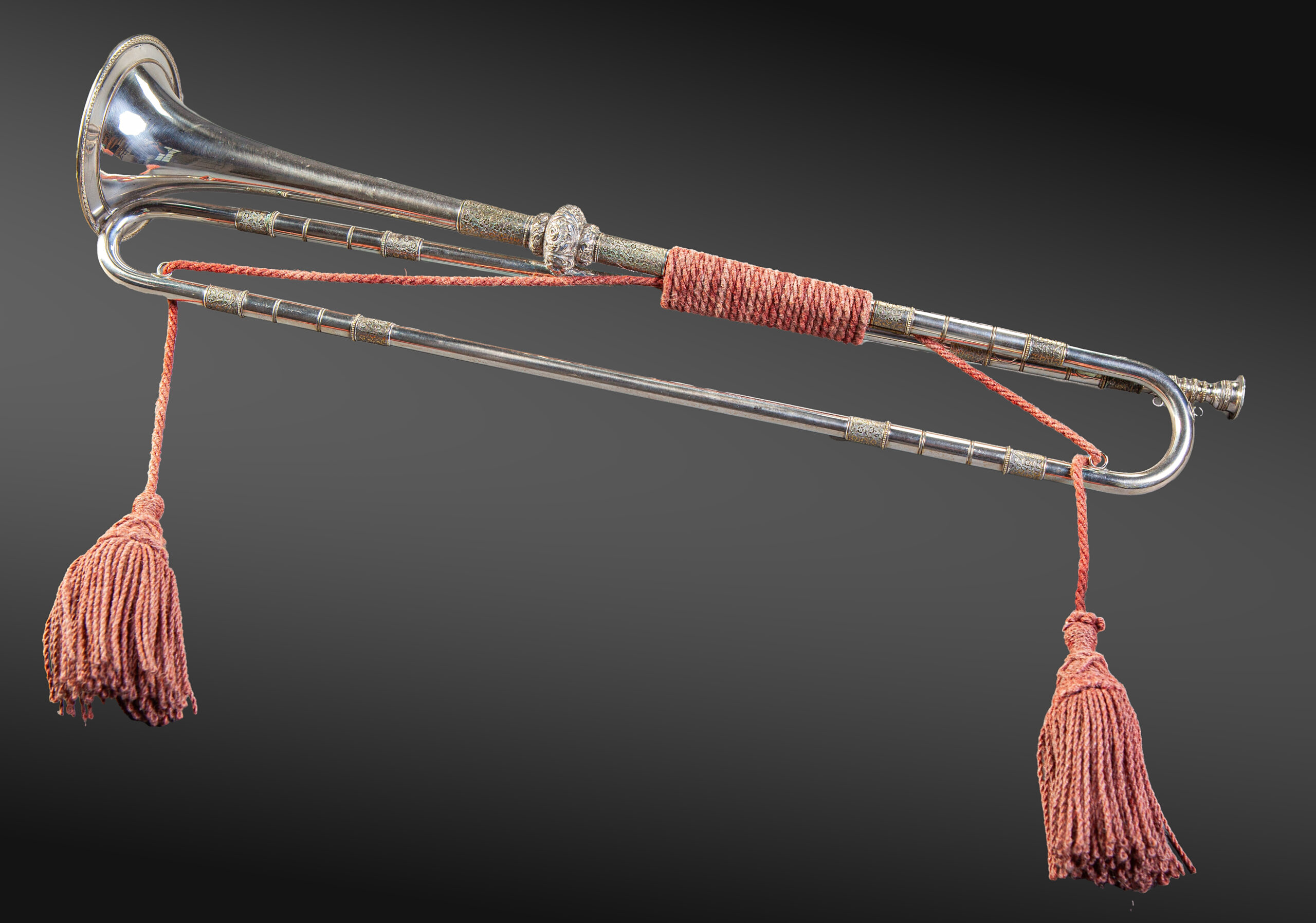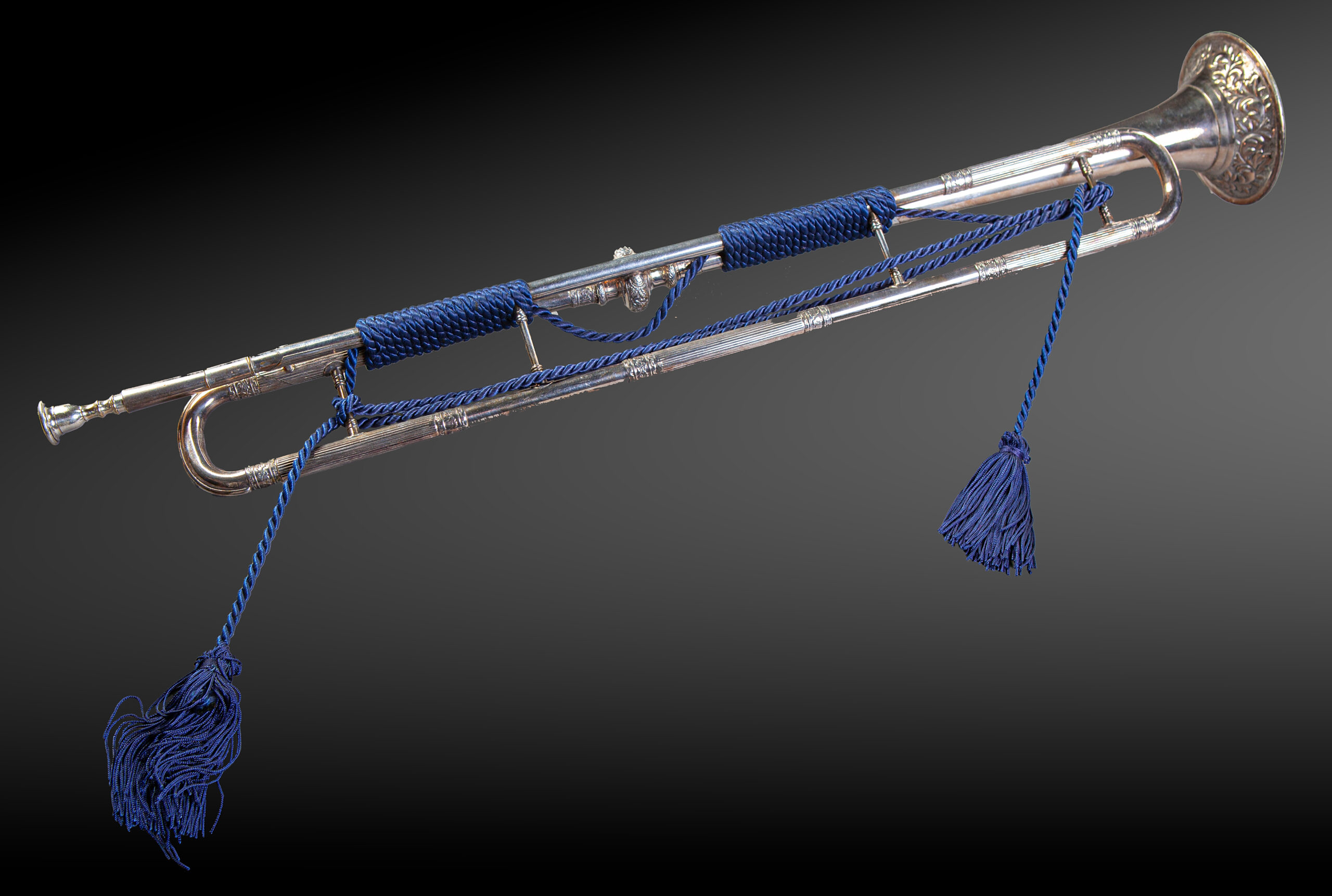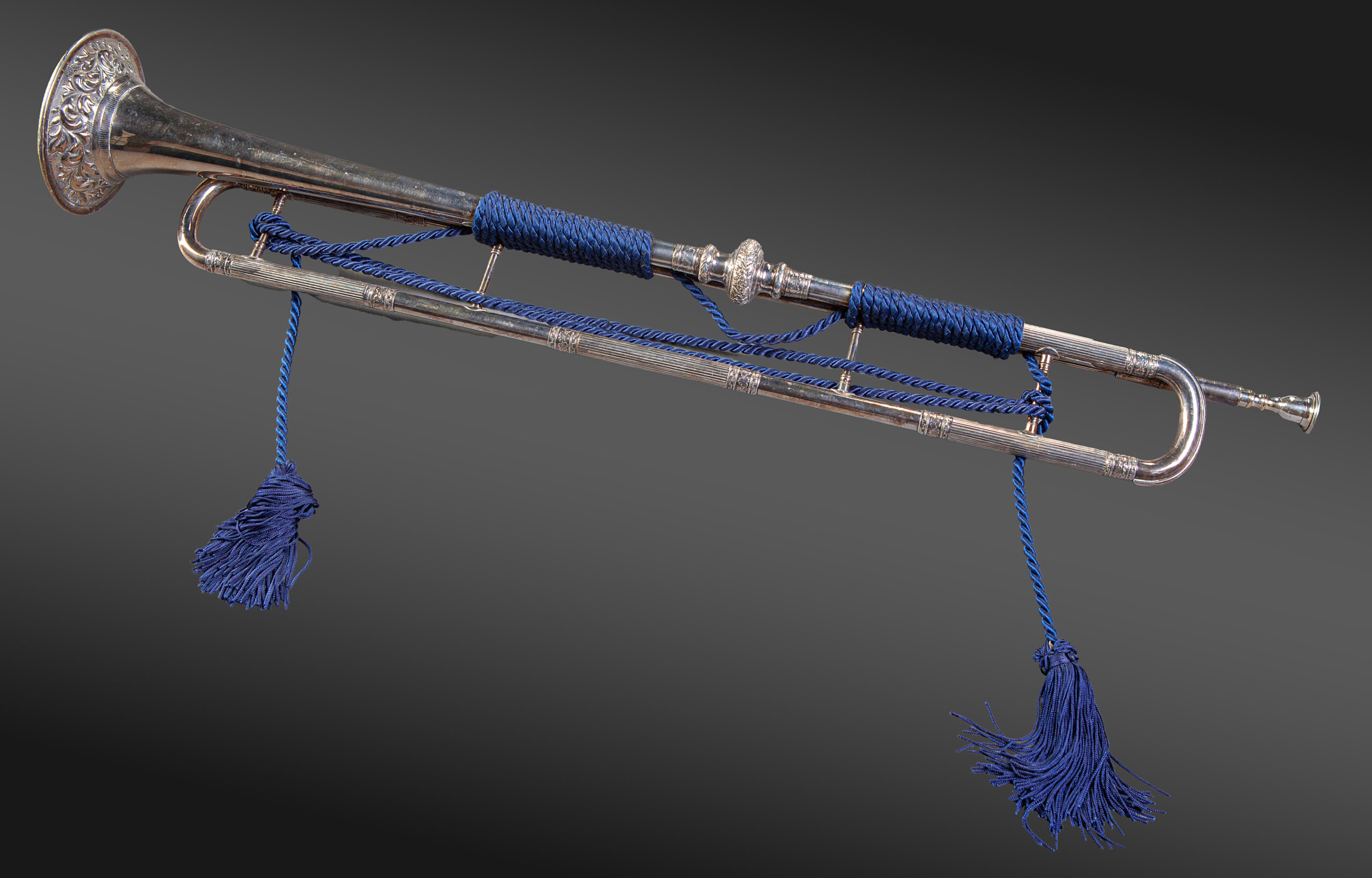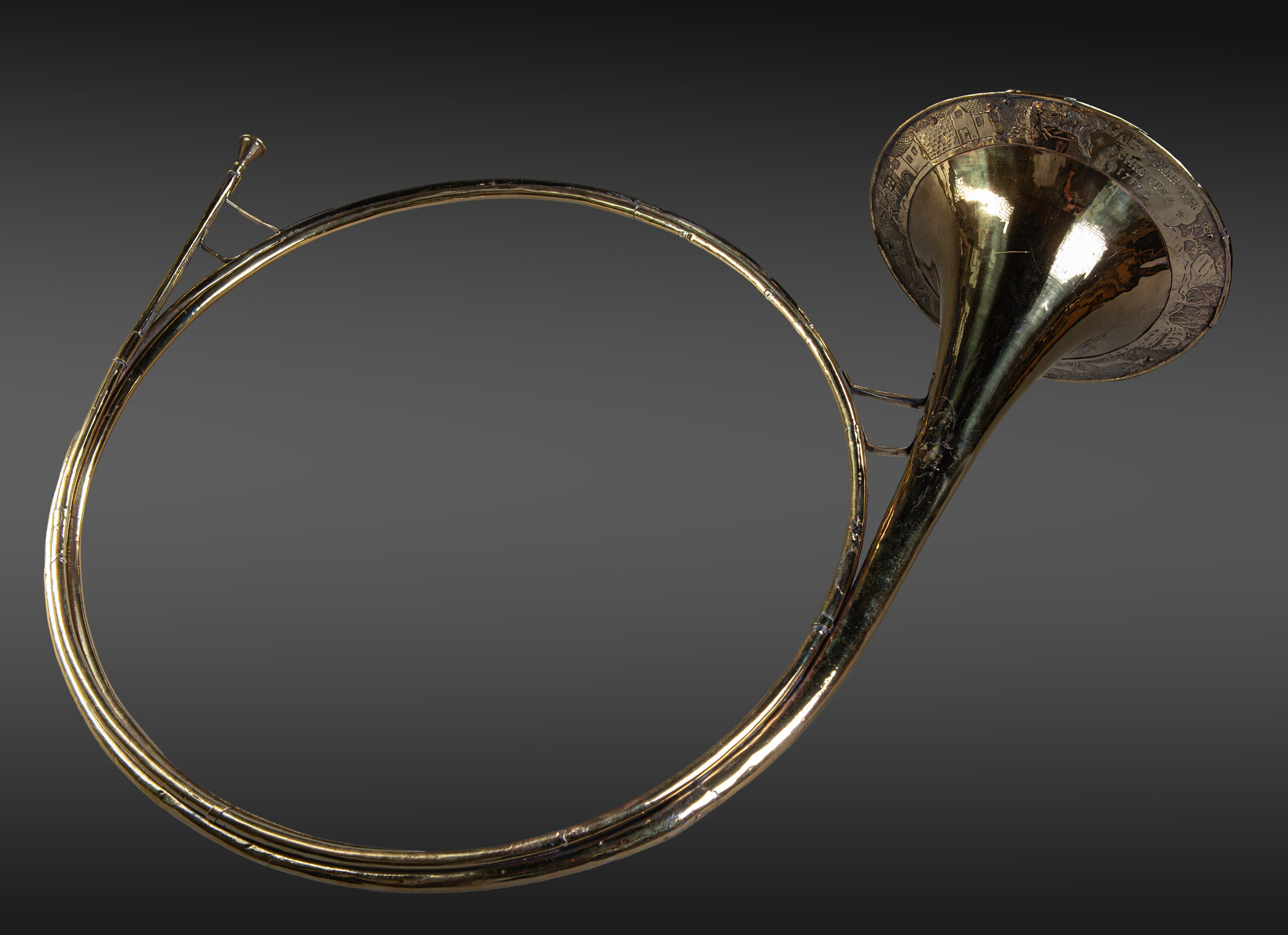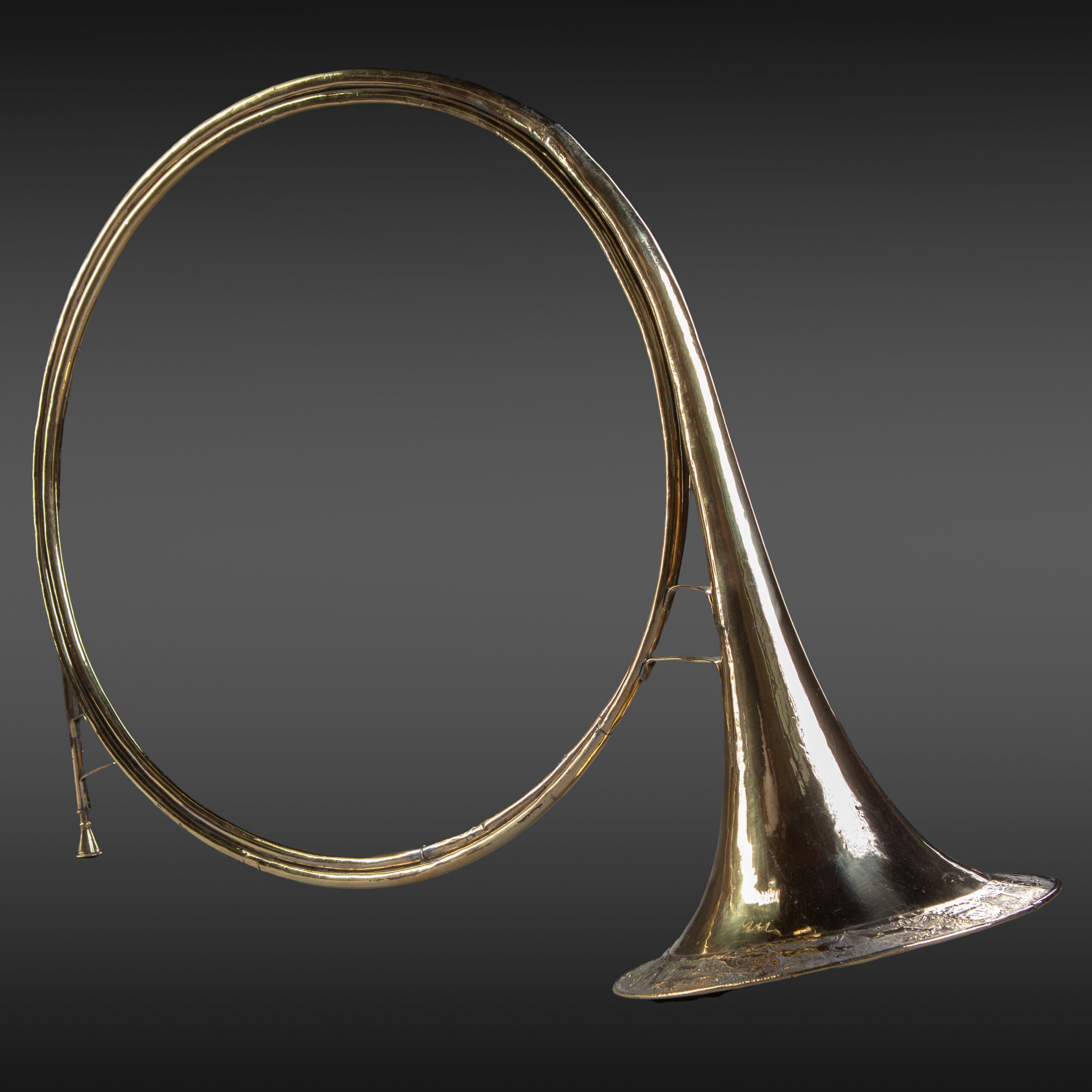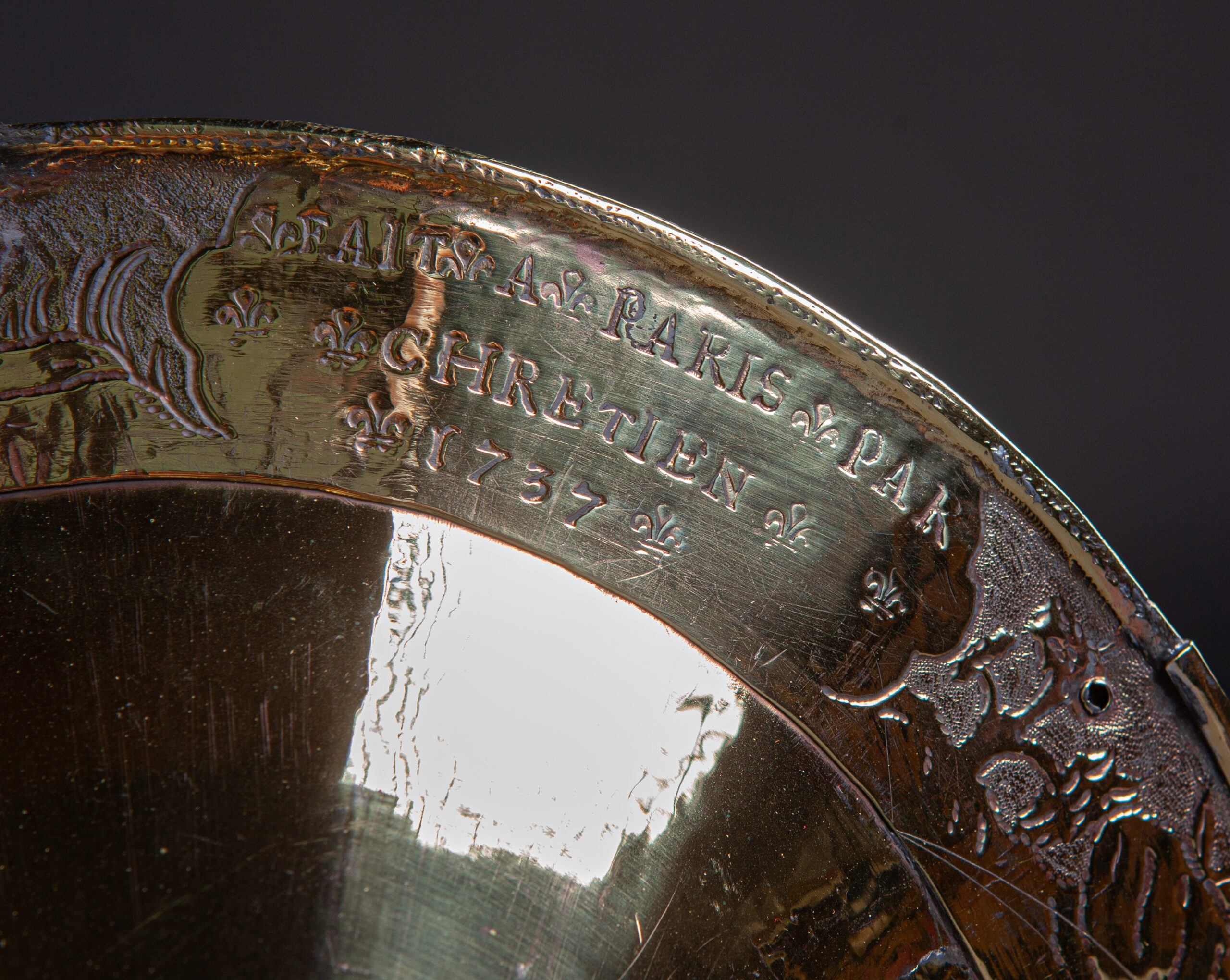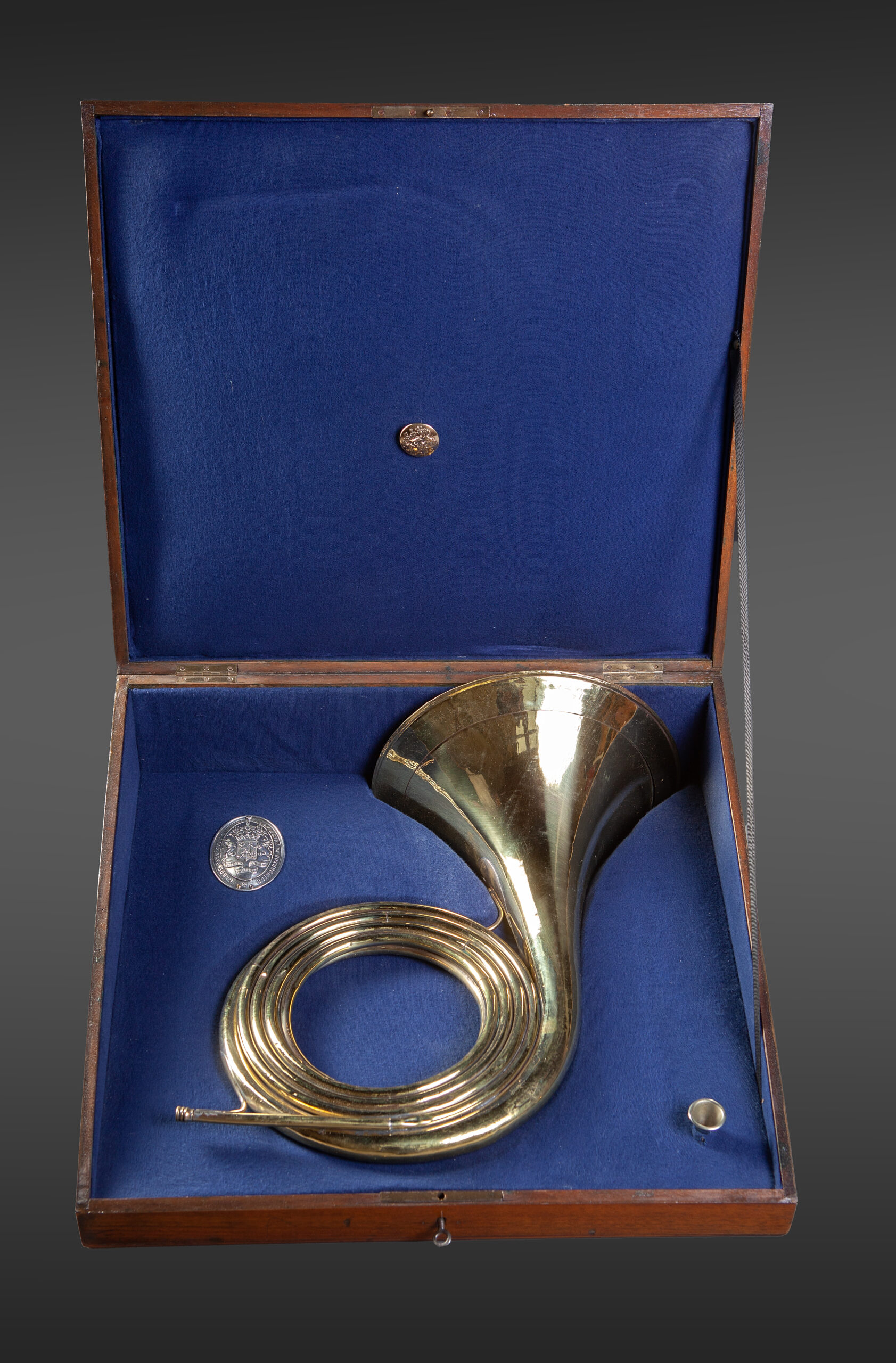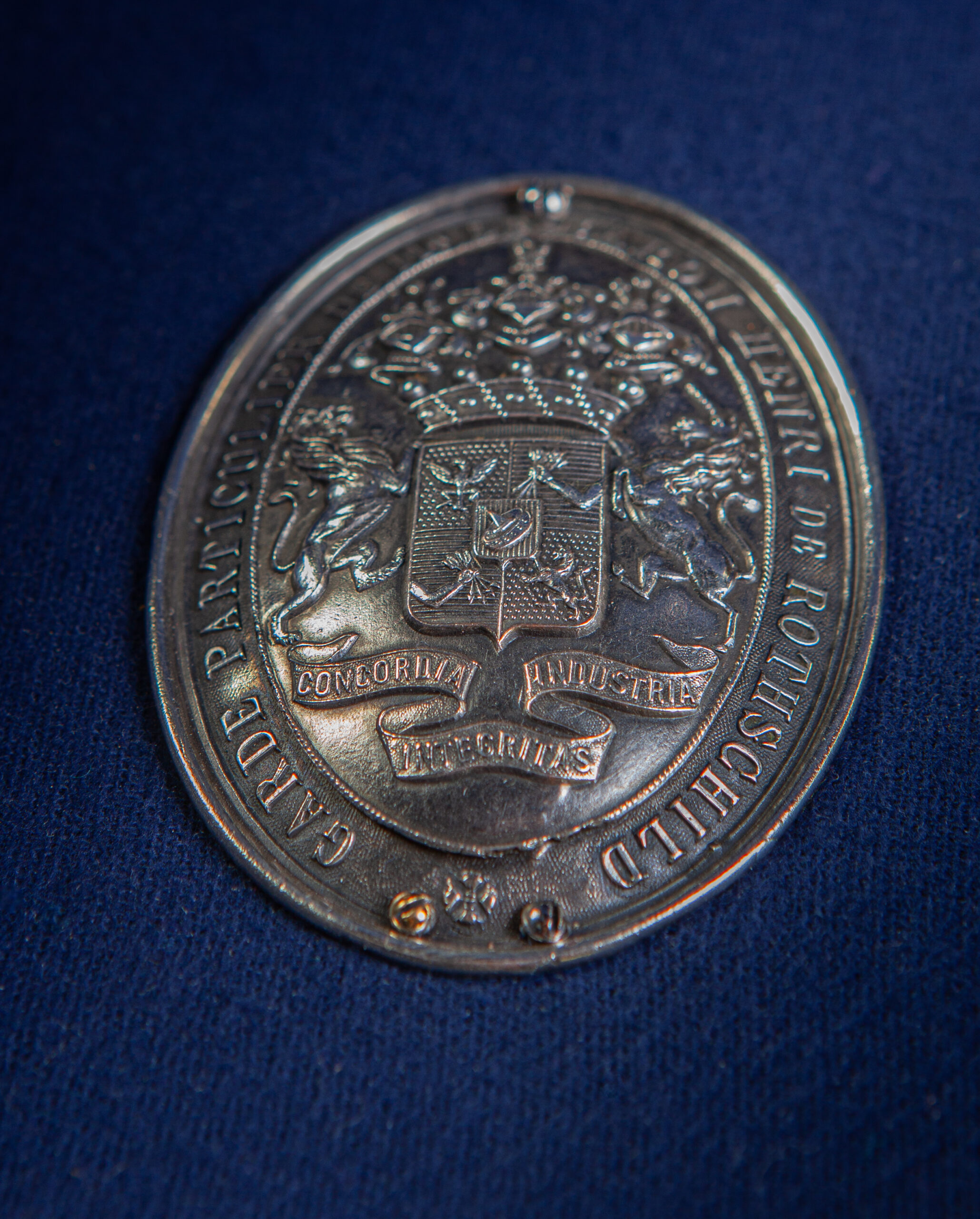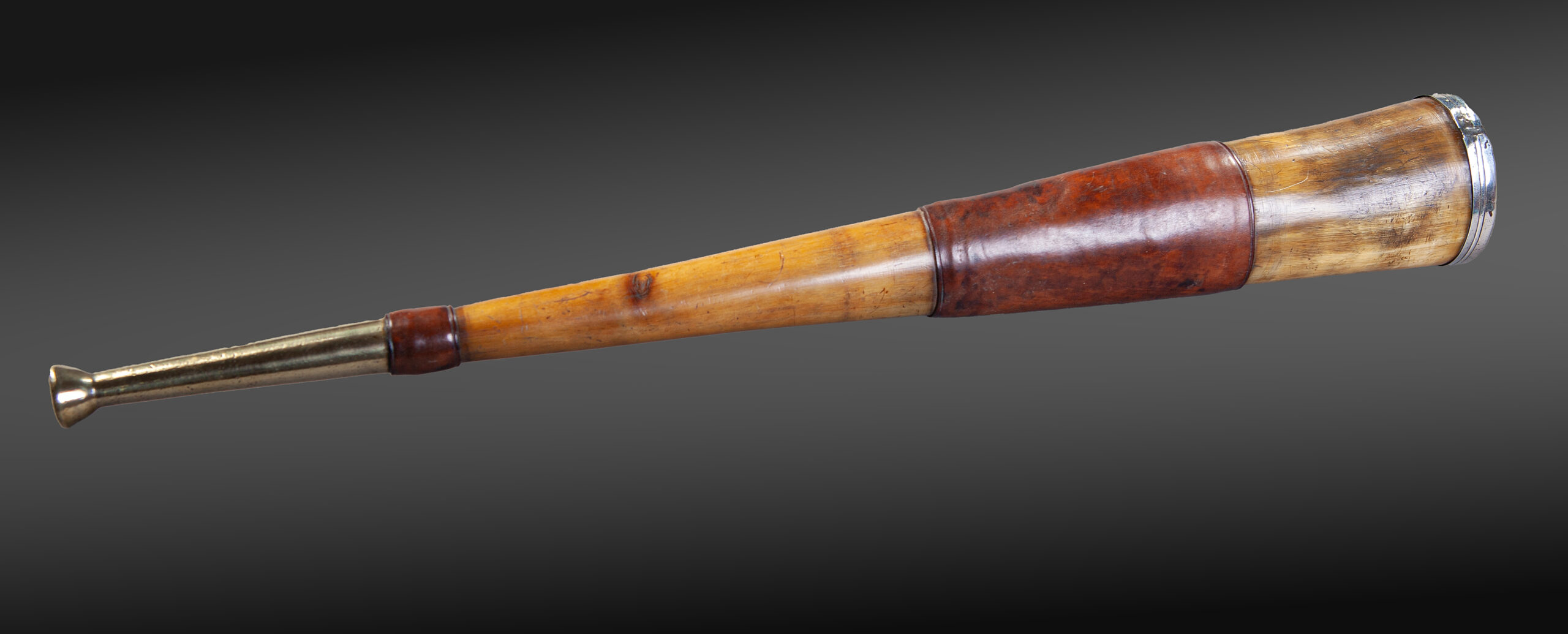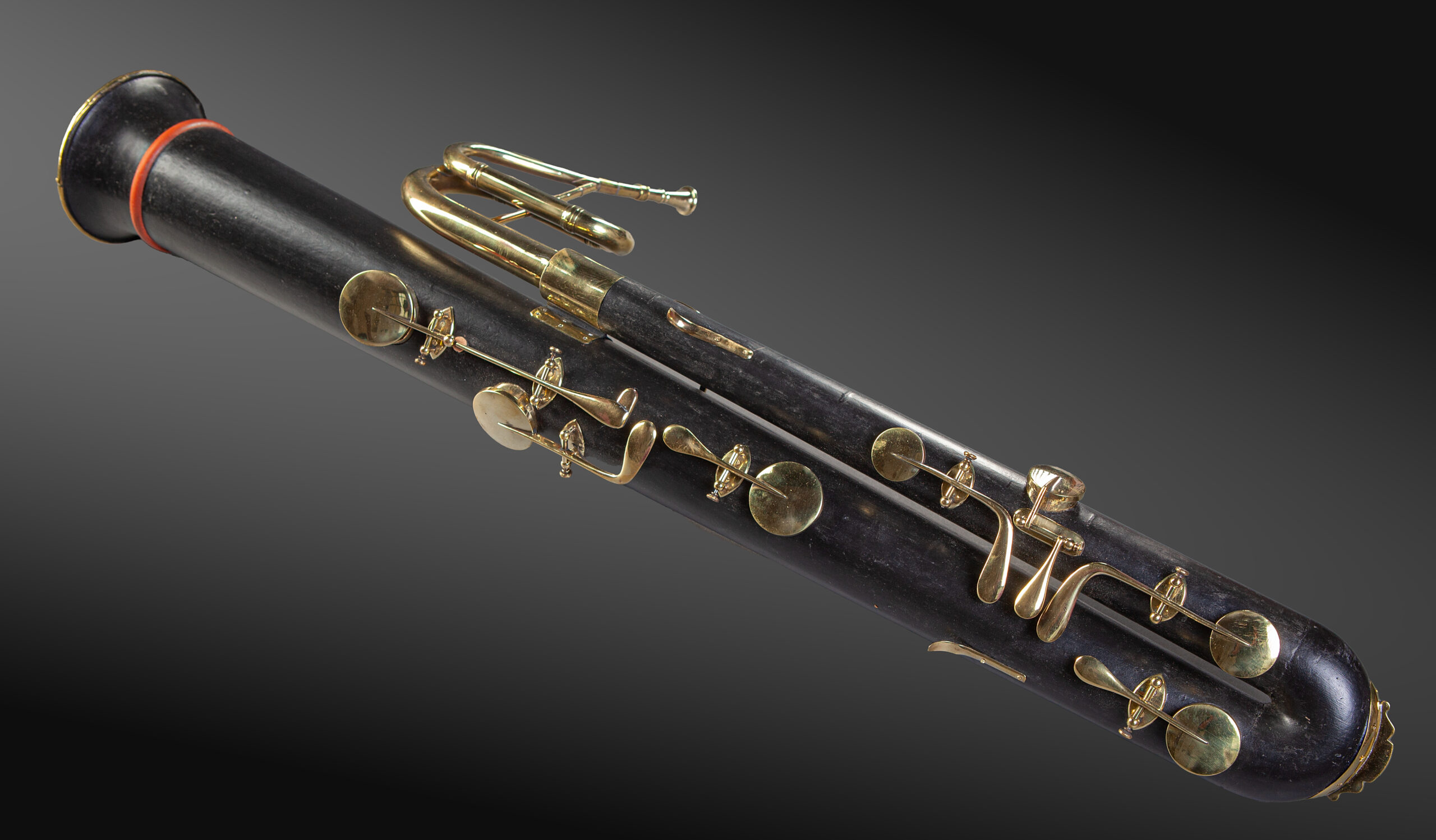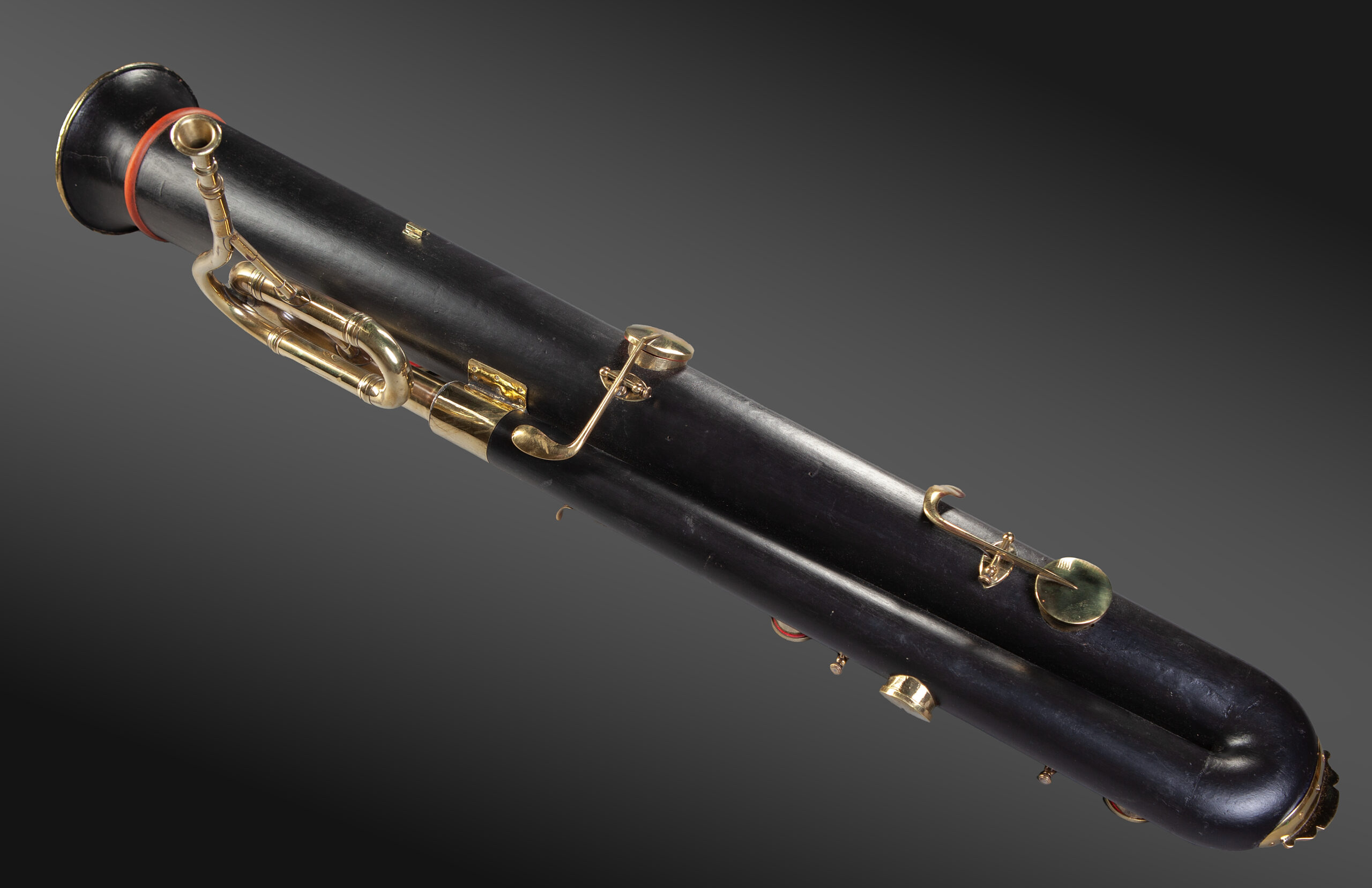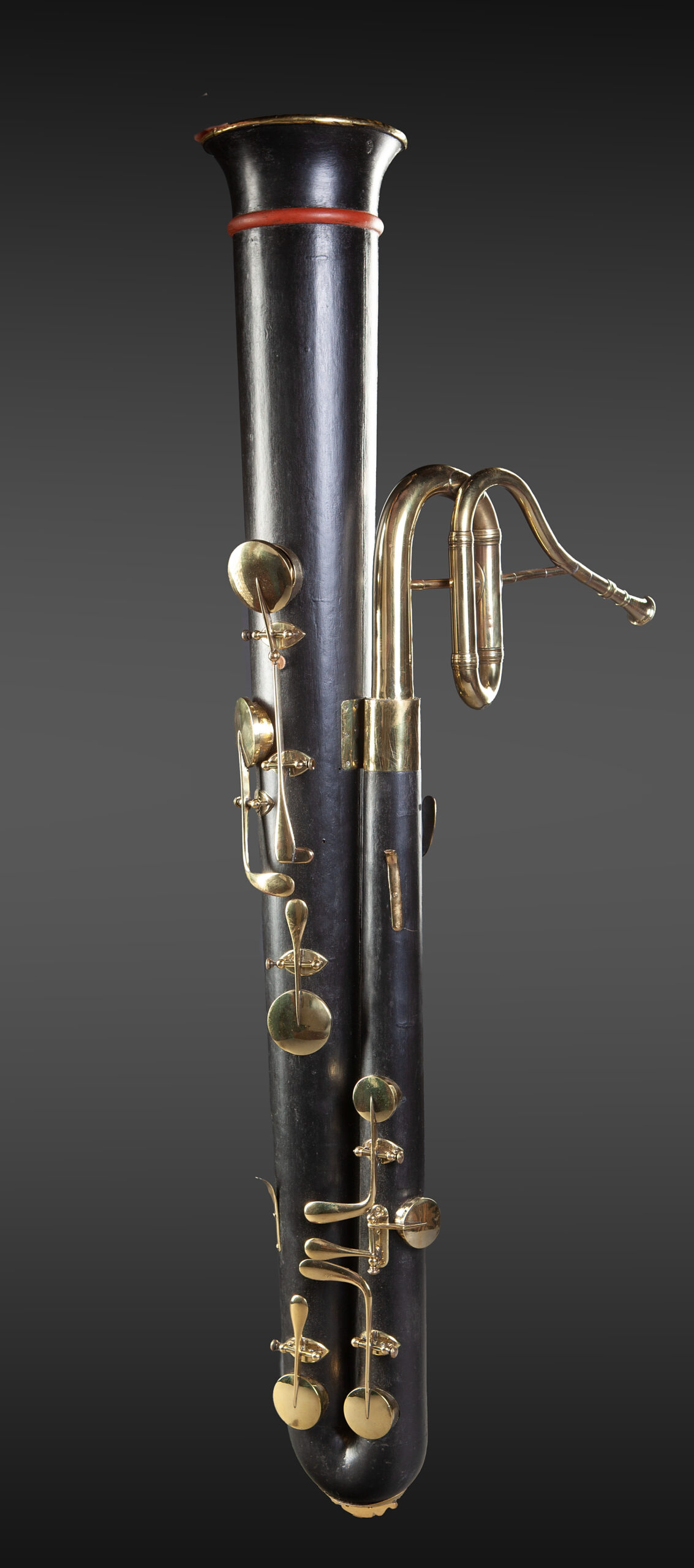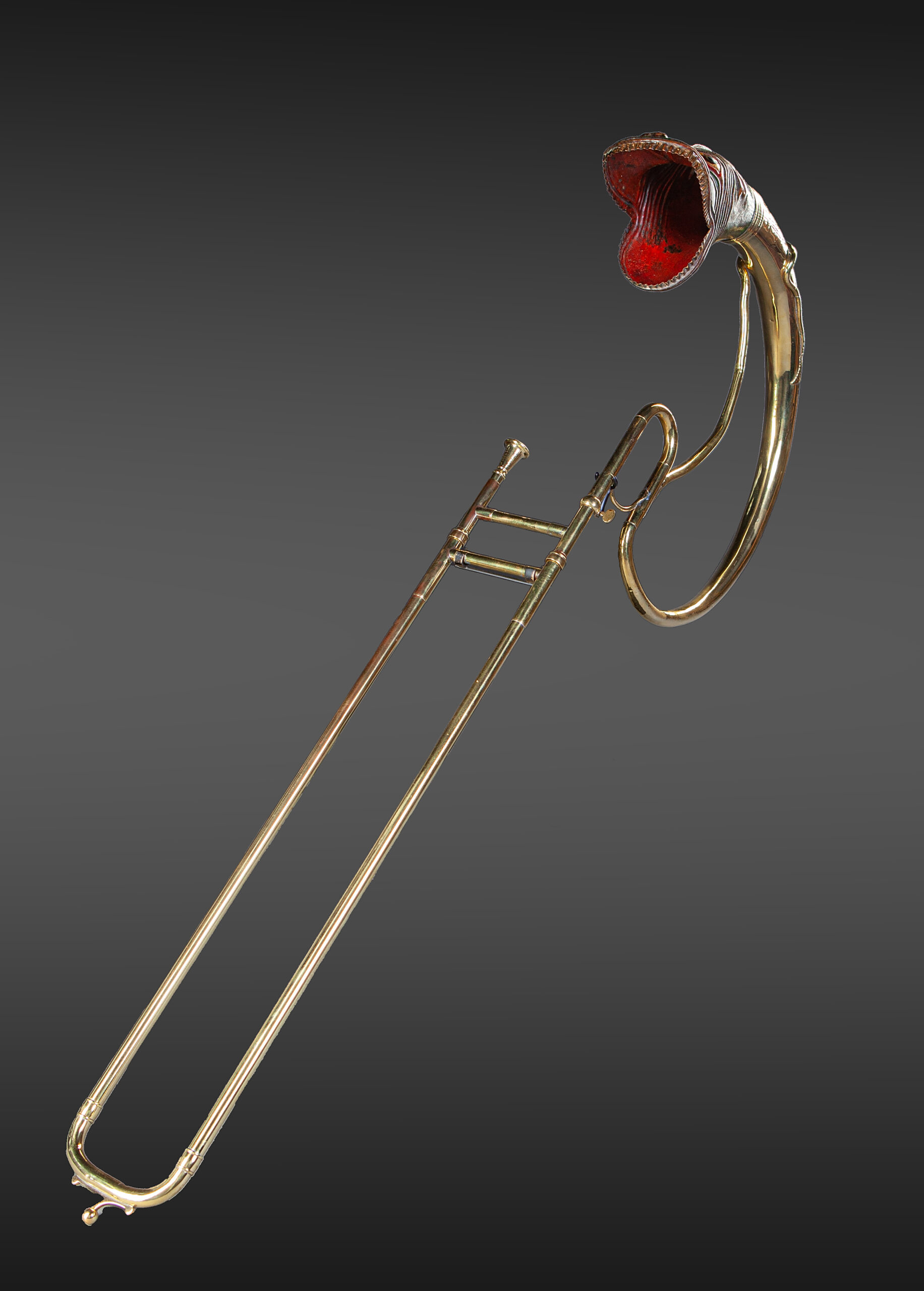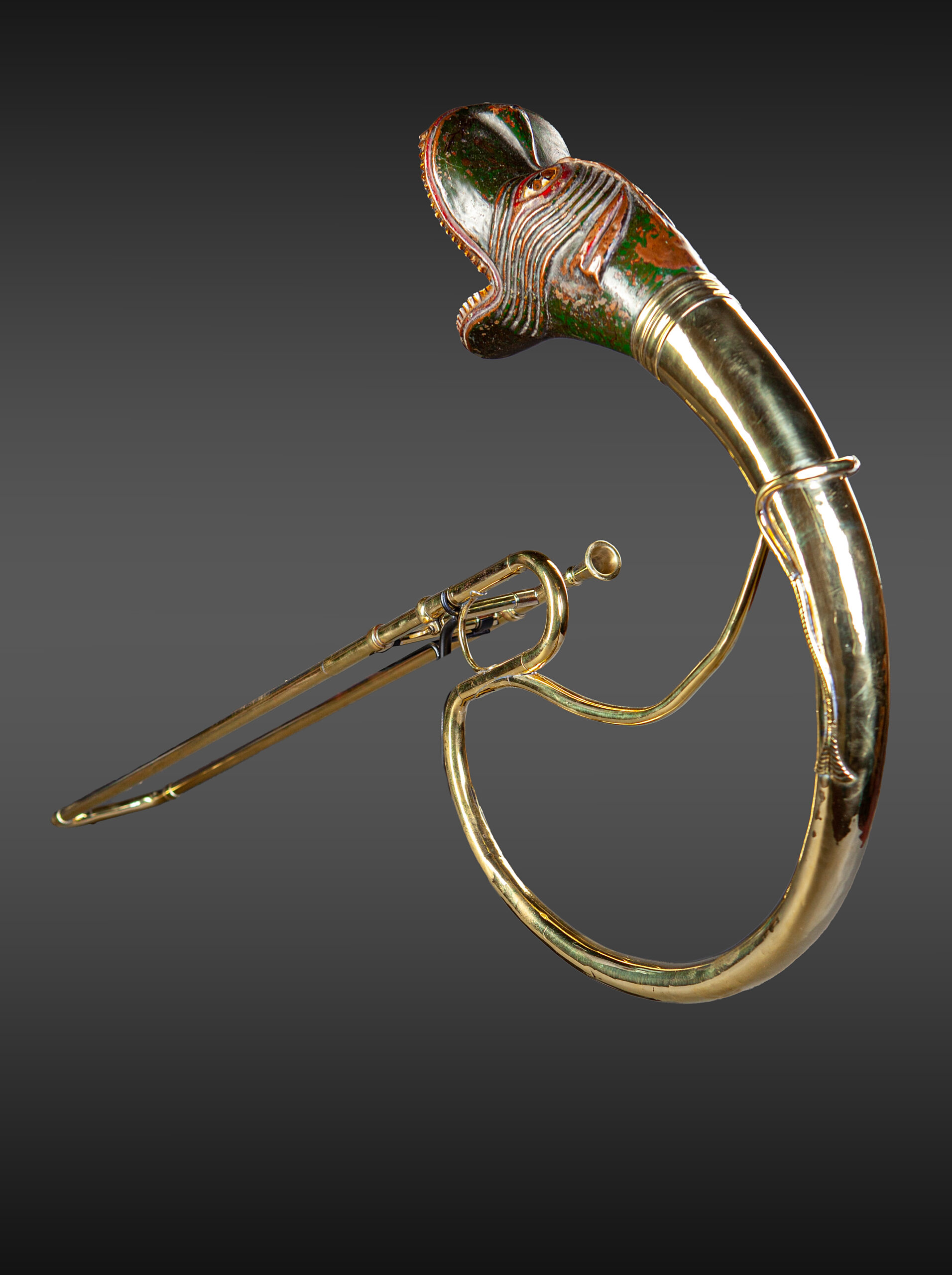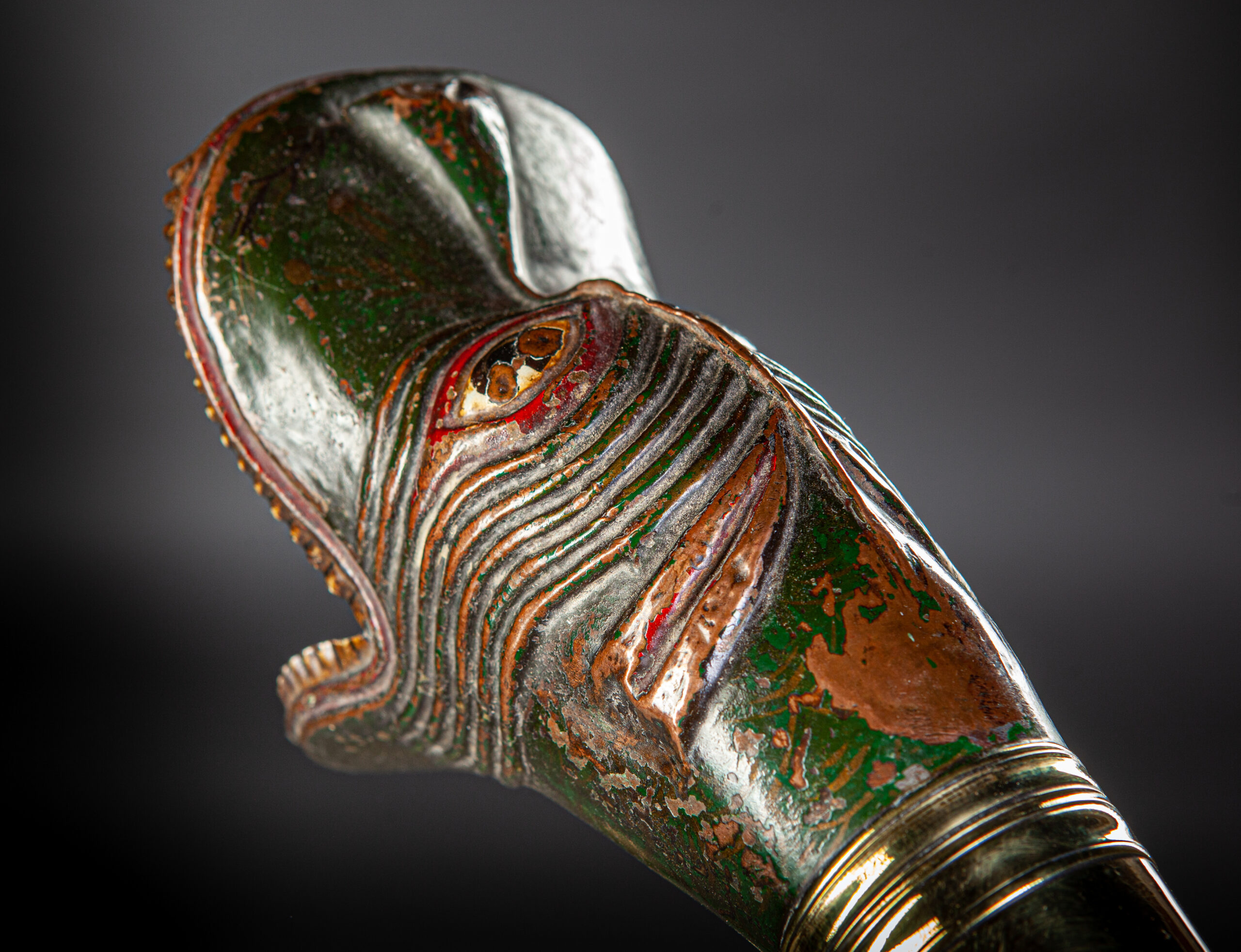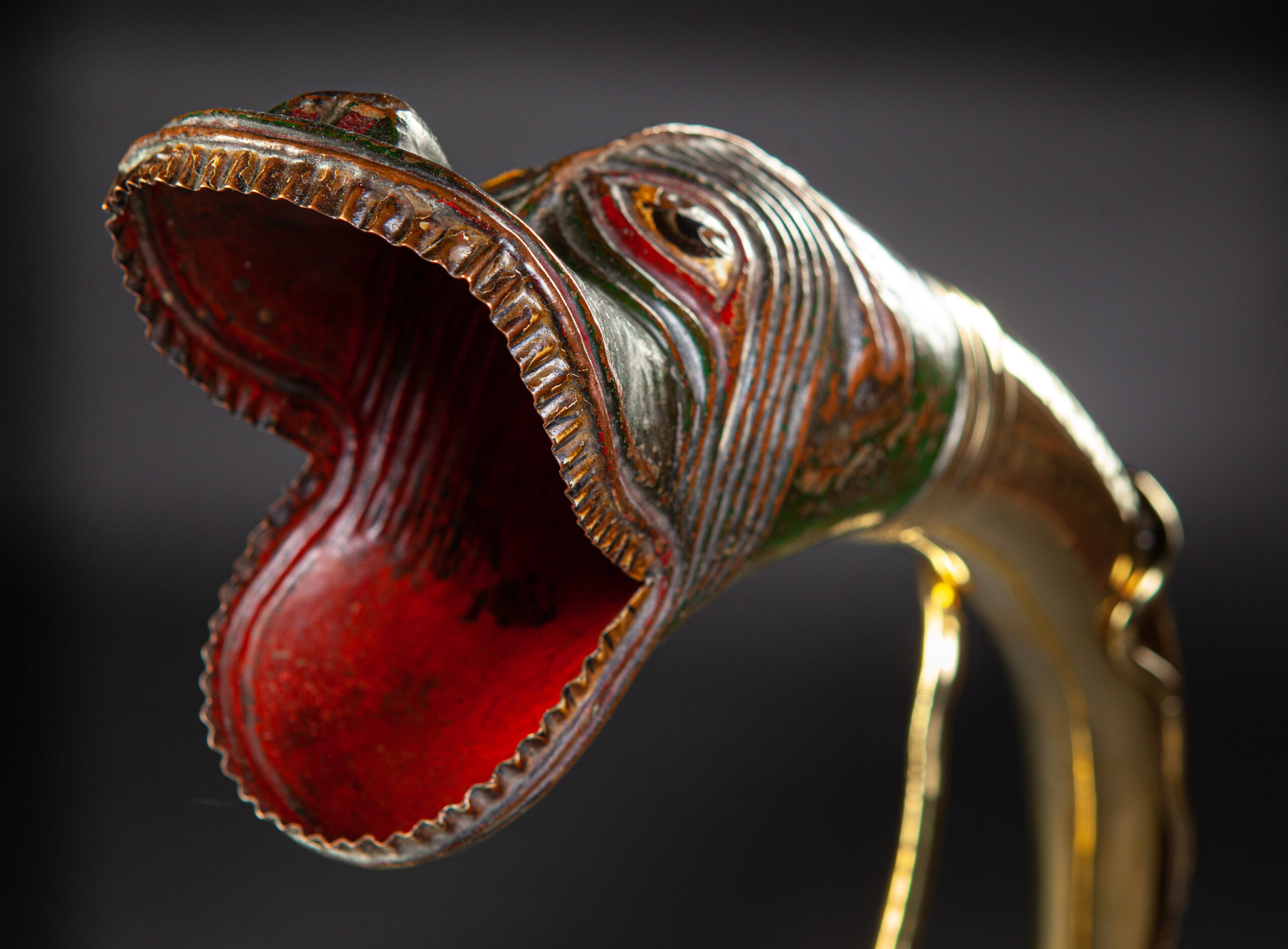HORN
16th – 17th century.
Stamped “VILLEDIEU” on the bell.
Horn mainly used for hunting, made of a sheet of brass in the shape of a half-moon.
The stamp “VILLEDIEU” does not relate to the name of the craftsman who made the instrument but to the corporation of brass beaters from the Norman town of Villedieu, which became “Villedieu-les-Poêles” (V. the pans) in 1962. The first Documents relating to brass working and boilermaking date back to the 13th century. From the 16th century, following the arrival of founders from Lorraine, corporations became widespread. They ensure the organization of crafts, the training of workers, the maintenance of the quality of work, discipline, etc.
The thickness of the materials, the assembly and the traces of burnishing visible on the surface of the instrument are characteristic of the period. Brass polishing will only appear later.
NB: Restorations have been carried out on a few cracks and on the bell (garland). The missing leather straps have been replaced.
Provenance: Werner Flachs Collection.
Bibliography: Das Jagdhorn, seine Geschichte von der Steinzeit bis zur Gegenwart. (The hunting horn, its history from the Stone Age to the present day.)
The Paris Philharmonie Museum has a small horn of the same origin, coming from the Clapisson collection (1808-1866) and mistakenly attributed to Boisset de Villedieu in the 1875 inventory.
SERPENT
Italy, 19th century.
Italian model in wood covered in bronze-green leather.
Slightly flared bell.
Brass bocal with a recently made black horn mouthpiece.
Height: 82cm.
Various restorations on the wooden part and the bocal replaced. The initially red interior of the bell was repainted with cochineal carmine, according to the custom of the time
SERPENT
France 18th – 19th century.
French model: wood covered in black leather.
Brass bocal, recently made black horn mouthpiece.
Height: 82.5cm.
NATURAL TRUMPET
England 19th – 20th century.
Signed on the bell: “Henry Potter & Co / 36-38 West street / Charing Road / London”.
Silver-plated brass. The ball and sleeves of the tubes are natural brass stamped with floral designs. Original mouthpiece.
Length without mouthpiece: 66.5cm.
NATURAL TRUMPET
England 19th century.
Silver-plated brass. The garland of the bell and the ball of the first tube are decorated with floral motifs.
No apparent signature, but the attribution of the instrument to the workshop of Joseph Higham (1818-1883) seems relevant.
Length without mouthpiece: 72.3cm
“DAUPHINE” HUNTING HORN
Chretien in Paris, 18th century.
Large brass hunting horn, with garland engraved with hunting scenes. Maker’s signature: “Made by Chretien / Paris / 1737” with fleurs-de-lys.
“Le Sieur Crestien” considered the best maker of horns and drums in “Le livre commode” by Abraham du Pradel (Paris 1692) descends from a Norman family of “boilermakers – horn makers” settled in Vernon then in Paris, rue de la Ferronnerie, from the end of the 17th century.
The so-called “Dauphine” horn was named in 1729 by one of its first makers, Lebrun, in homage to the birth of Louis XV’s son. The king, passionate about hunting, asked the Marquis de Dampierre to take command of a new crew dedicated to deer hunting: the crew of the Chiens Verts which began in 1738.
A series of horns was ordered from the Sieur Chretien, “ordinary of the King’s music”.
We have listed three identical models from this maker dated 1737
MARICOURT HUNTING HORN
Michaud in Paris, 19th c.
Noël Firmin MICHAUD was a maker of brass instruments established in Paris between 1832 and 1867. He filed several manufacturing patents and received a silver medal for his horns at the 1849 Industry Exhibition.
The tight winding of post horns or signal horns has existed at least since the 16th century, but its adaptation to the hunting horn became widespread in the 19th century during the development of court hunting. This model, called “Maricourt”, made it possible to participate in the event from a horse-drawn carriage.
The six and a half turn instrument is kept in its wooden case.
The plaque “private custody of Baron Henri de Rothschild” was made for the visit of the King of Portugal, Don Carlos, to the Abbey of Vaulx de Cernay during the hunting campaign of December 8, 1905.
Provenance: Coll. Georges Paquier, Château de Seganges (Allier) and auction Château de la Muette. Ader S.V.V.
Bibliography (for patents and participation in exhibitions): Comte de Pontécoulant: “Organography: essay on instrumental making, art, industry and commerce.” T.II, Paris, Castel ed. 1861. (Reprint: Frits Knuf, Amsterdam 1972)
SIGNAL HORN
United Kingdom / India; 19th-20th century.
Horn, brass, leather, silver.
An English inscription on paper slipped inside reads: “Tibetan horn collected by Colonel Fortescue / by Younghusband in 1905 / voyage of exploration to Tibet / See Finch (catalogue?)”.
Colonel Hugh Fortescue (1888-1958) and Colonel Francis Edward Younghusband, (1863-1942) both had careers in the English colonial army. One in Africa, the other in India. F.E. Younghusband participated in the Tibet expedition (1903-1904) and it was on his return, according to the document, that he offered the instrument to Colonel Younghusband.
Length: 56.8cm
OPHICLEIDE
France 19th century.
Wooden model. Key of C.
We have only listed three wooden ophicleides so far. One is at the Army Museum, at Les Invalides in Paris; we were lucky to find the other two.
The instrument is composed of two parallel conical parts, connected at their base by an elbow, and a brass bocal, with a tuning slide.
Nine brass keys with round plates.
Height: 108cm
BUCCIN -TROMBONE
Alto model; beginning of the 19th century.
Coming from the ancient fashion widespread at the end of the 18th century, notably following the archaeological discoveries of Pompeii and Herculaneum, the buccin was used in July 1791 during the funeral ceremonies of Voltaire at the Pantheon.
Equipped with a trombone slide, its use became widespread during the Napoleonic period in most European countries.
As is often the case, the instrument is not signed, but it looks like the Lyon productions of the time.
NB: The presence of a small tuning slide at the junction of the two parts of the instrument – which does not appear on the bass-buccin trombones – has until now been observed on the three alto-buccin models listed .
Materials: Brass, pigments.
Average diameter of the upper part: 40cm
